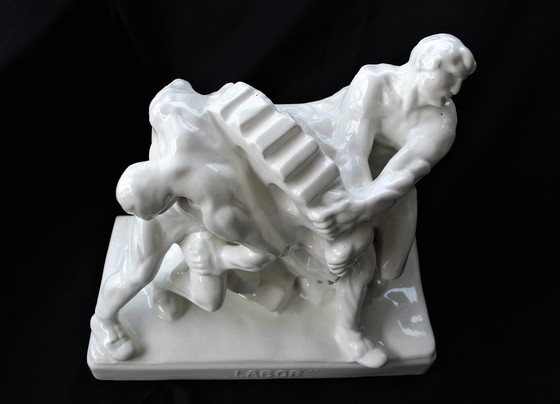Have it delivered hassle-freeBuyer protectionAll Designer items curated by WhoppahDownload the Whoppah app here

Item not as advertised, money backHave it delivered hassle-free or pick it up yourselfShop only from Trusted Sellers
Skipscollectables
Product description
Social Realisme Sculpture Years Art Deco 1920 1930 Design by the Hungarian István Lőrincz
Made by Kispest, Hungary
Beautiful image in the spirit of the ideals of socialism.
Image is stamped on the bottom and is signed on the left with Lőrincz
It says "LABOR" which means work.
Early works by Lőrincz are almost impossible to find, not this one at all, really a rarity.
Height 28.5 cm Pedestal 32 x 16 cm
4360 grams
István Lorincz
1918: Proletarian Fine Arts Workshop; 1919-1922: Hungarian College of Applied Arts, masters: Lajos Mátrai, György Zala. 1937: Honorary recognition of the Szinyei Merse Society, 1938: Professional Silver Medal of the National Association of Hungarian Applied Artists; 1940: Gold Medal for Applied Arts. 1942: Budapest Gold Medal for Applied Arts in Budapest. From 1938 he was studio manager of the Herend Porcelain Factory, 1949-56: he was head of the porcelain department of the Hungarian College of Applied Arts. Since 1957 he has been working as a freelance artist. In his studio he created porcelain ornaments fired with metal oxides and white top glaze, and conducted material and glaze experiments. Semi-porcelain objects in combination with metal were a technical rarity in the 1960s.
About the factory in Kispest (1922-1950)
The factory was further developed in 1922 from Porcelain factory - Kőedény és Kályhagyár Rt. Construction of the new factory began in April 1923 and production began in April 1924 with 81 men and 17 women, and by the end of the year the number had risen to 200 and was headed by Czech specialist Dr. Lipót Basch. The factory was one of the most modern factories of its time, even in the eyes of Europe. Hungary's first tunnel kiln was established here. Artisans were employed in the design of his fine ceramics factory, and most of them worked from foreign samples and orders. The factory was nationalized in 1948 after the war. In 1950 it was renamed the Fine Ceramic Works Granite Grinding Wheel and Stone Factory. In 2003 the factory was permanently closed.
Marks, see photo
The marks of the Kispest factory are easy to spot. I know the four types of characters shown in the picture. The first round seal version was used until the 1930s. The triangular seal mark was used for almost all faience products until closure (faience is a type of crockery pottery). The triangular 3K could be used from 1930 to 1950, and KGyCs to the day of its closure. On the porcelain objects in Kispest there is also a KP sign and the laurel branch (far right), especially on figurines and cups.
Beeld heeft leeftijd gerelateerde craquelé en scheuren die ontstaan door spanningen tijdens het bakken en hoge leeftijd. Zie achterkant waar een spanningsscheur doorloopt naar onder en de enkel van werker links. Het zijn scheuren die ontstaan in de oven. Aan de rand onder wat kleine beschadigingen likt het. SHIPPING: Shipping costs are what I have to pay to ship it, nothing more. Shipping costs in advertisement are not correct but can not change it. Ask shipping costs before making a bid. Shipping is very reasonable. Example, shipping to America 1 kilo € 25,- 2 kilos € 29,- 5 kilos € 59,- 10 kilos € 95,- Within Europe cheaper!
Beeld heeft leeftijd gerelateerde craquelé en scheuren die ontstaan door spanningen tijdens het bakken en hoge leeftijd. Zie achterkant waar een spanningsscheur doorloopt naar onder en de enkel van werker links. Het zijn scheuren die ontstaan in de oven. Aan de rand onder wat kleine beschadigingen likt het. SHIPPING: Shipping costs are what I have to pay to ship it, nothing more. Shipping costs in advertisement are not correct but can not change it. Ask shipping costs before making a bid. Shipping is very reasonable. Example, shipping to America 1 kilo € 25,- 2 kilos € 29,- 5 kilos € 59,- 10 kilos € 95,- Within Europe cheaper!
Specifications
ConditionVery goodColorsWhiteMaterialPorcelainNumber of items1StyleVintage, Art DecoHeight28 cmWidth32 cmSigns of usageCrack















